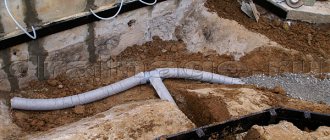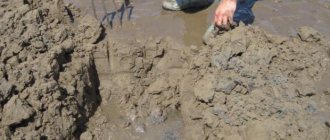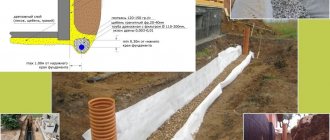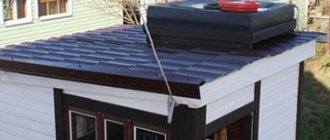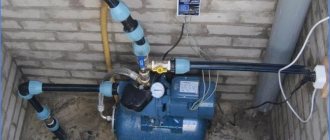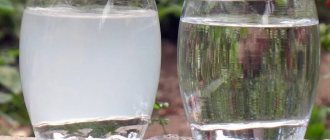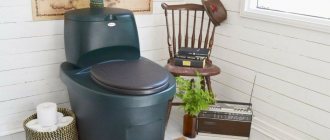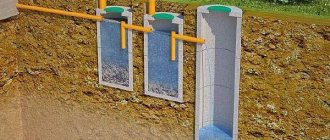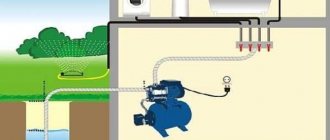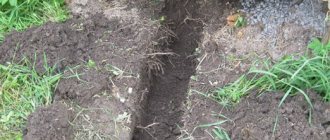If a country house on the site is constantly flooded, and the dirt in the yard does not dry out, this indicates the presence of a high groundwater level. This inconvenience can be corrected with the help of drainage in the country. The implementation of such a project does not require special skills, so the cost of the work will be low; moreover, the drainage system in a summer cottage can be done independently.
In what cases is it necessary to arrange drainage for a country house?
The need for a drainage system in a suburban area is always visible to the naked eye - waterlogging of the soil after melting snow or precipitation, the presence of dampness in the cellar or puddles that do not dry out indicate the need to create a drainage system. Already when purchasing a plot, you can note the need to transform it: ⊗ The plot is located in a lowland - seasonal flooding due to changes in relief is inevitable. ⊗ Clay or loamy soils are slightly hygroscopic, and therefore water stagnates on the surface for a long time. In this case, the clay may not be visible if it is hidden behind a layer of black soil. ⊗ The close location of groundwater within 2.5 meters from the soil surface during rain is quite capable of turning the area into a swamp. Having dug a hole up to half a meter deep, you need to monitor it for 24 hours - if the hole fills with water, then arranging drainage is a priority. ⊗ The reason for the need to arrange drainage may not be the relief or quality of the soil, but the abundance of precipitation. In this case, due to rains, the soil is depleted of oxygen, which negatively affects the growth conditions of plants - without additional drainage it is not advisable to engage in gardening or gardening in such conditions. After making sure that one or more factors from the above list are present, you can begin to create a drainage system.
Typical errors
The desired result will not be achieved if one or more of the following shortcomings are allowed:
- no slope in the direction of the catchment basins;
- insufficient depth of pipes;
- using a drain diameter or perforation that is not suitable for a particular soil type;
- ignoring crushed stone bedding and installation of geotextiles;
- insufficient number of drainage elements;
- accelerated filling of the drainage well.
Types of drainage systems
The problem of excessive humidity is solved through two types of systems - they can be surface and deep. The choice of the required option is determined by the reasons that caused the flooding of the territory. It should be noted that each of the above systems complements each other, and if a storm sewer system is used, a logical and technically competent system for the complete drainage of both groundwater and storm water is formed.
Surface drainage system of a country house
The rainwater inlet system will allow you to effectively collect and drain unnecessary water outside the site during any rainfall. The efficiency of water drainage allows you to avoid the absorption of moisture into the soil - such a drain is necessary for clay soils and will become a functional addition to storm sewers. The water is discharged into filtration wells; alternatively, it can simply be removed outside the site. The remaining small percentage of precipitation will naturally evaporate. As for the possible types of surface drainage systems, you can choose the following options.
Point drainage
Point drainage involves the use of: ⊗ storm funnels; ⊗ storm water inlets; ⊗ ladders; ⊗ door grilles. Such structures are installed in door pits and other areas where water collection is required - this can be either draining a roof storm drain or a watering tap. Through a point water collector, water enters underground pipes, and then into the storm sewer collector.
Linear drainage
As for linear drainage, depending on the location it differs into wall and remote from the structure. This drainage is covered with lattice overlays and collects that part of the precipitation that does not fall into the point storm inlets. It is used in the following cases: 1. Prevention of washout of the top fertile soil layer, which is important for areas with landscape changes. If the horizon tilt exceeds 3 degrees, then this outcome is most likely. 2. If the landscape on the site is fairly flat, but the site itself is located in a lowland, then during precipitation, streams of water flowing from the heights also threaten the fertile layer, as well as plants and houses. 3. Draining of sidewalks and paths - the pedestrian area is located on a slight elevation, while moisture flows down a small slope into the drainage channels. 4. Road drainage - is an ordinary ditch along the road surface.
Deep drainage
This drainage option is relevant for areas where groundwater is located close to the surface, in particular closer than 2.5 meters. It makes sense to create such a drainage system simultaneously with the pits for the foundation of the house and outbuildings, so that they do not flood. Construction is carried out using perforated pipes - the so-called drains - they are laid in the ground at an angle, which allows moisture to collect in the drainage and, under the influence of gravity, move into a storage collector, drainage tunnel or well.
Important!
The slope of the drainage pipes should be within 1 degree; alternatively, we can say that the height difference per 1 meter of pipe should be 1-2 cm.
How much could such work cost?
Groundwater drainage work may cost more than the value of the house. Doing the work yourself will significantly reduce the cost. Here are approximate prices for the work:
| Works | Unit | Using special equipment | Manually |
| Surface drainage (depth from 0.5 to 1.0 m) | p.meter | from 1000 rub | from 1300 rub. |
| Deep drainage (depth from 1.0 to 1.5 m) | p.meter | 1400 rub. | 1500 rub. |
| Installation of a manhole up to 1 meter | PC. | 3000 rub | |
| Storm sewer installation | p.meter | 650 rub. | 900 rub. |
| Installation of storm water inlet | PC. | 1000 rub | |
| Installation of a collector well, depth 3 meters | PC. | 20,000 rub. | 24,000 rub. |
Alternative options for draining a summer cottage
Drainage at the dacha can be organized in various ways, some of which are quite simple and do not require significant labor costs. But in any case, abandoning the classic solutions using drainage pipes and channels, the effect of non-standard solutions will not appear immediately, but only after a significant period of time. This is due to the fact that a properly designed and installed system based on plastic pipes and trays actually only increases the rate of collection and disposal of groundwater, in other words, it accelerates natural and physical processes. Alternative options, in turn, will only change the conditions for the processes of penetration of groundwater into the soil.
Saving Tips
It is not necessary to purchase the most expensive advertised pipes. There are many products, time-tested or new, but at more affordable prices. It is better to use asbestos-cement or corrugated plastic pipes with large perforations.
It is better to buy materials in hypermarkets or large construction markets. You should not save money by using used materials. In some cases and in non-critical areas, the pipe can be replaced with a “house” made from scrap materials (solid brick, stone).
Drying an area without drainage
To drain the area, it is worth understanding the causes of waterlogging. In some cases, the situation can be corrected without installing drainage. An example of such a situation could be a specific topography, which causes increased soil moisture - in this case, you can create a slope along which water will flow outside the site. To do this, it is necessary to make a difference in the relief, providing a slight slope due to the formation of an artificial hill. The soil on one part of the site is removed, and on the other it is poured. Alternatively, you can make a mound of black soil or peat, mixing it with 1/3-1/5 parts of sand. If the cause of high humidity is the presence of a layer of clay near the surface, a real pond can appear in the lower part of the site, which, in addition to its aesthetic properties, will be an excellent way to dispose of drainage water. Such a reservoir can become a natural source of water for watering plants, a place for breeding fish, or simply a decorative element of landscape design.
If the groundwater level is high enough, then waterproofing the pond and reservoir will not be necessary; in extreme cases, you can use PVC film. The presence of aquatic plants along the perimeter of the artificial lake will prevent the water from blooming. Another option for draining the soil is to plant moisture-loving plants. A striking example of such a plant is birch, which consumes a huge amount of moisture for its growth. To drain the area, you can use plants such as willow, spirea, rose hips, hawthorn, and serviceberry. They are planted in problem areas, as well as along areas where moisture is undesirable, for example, along the road, around the perimeter of the house. This is a striking example of the combination of functionality and visual appeal.
Blind area: meaning and installation
An additional element to protect the building from excess moisture is the blind area. It complements drainage. The blind area is the laying of waterproof material around the perimeter of the foundation, adjacent directly to the building.
The material should be positioned strictly at an outward angle to allow moisture to drain away. Thus, when water hits the blind area, it is immediately removed from the house. Contact of the foundation and walls with moisture will be minimal.
As a material suitable for the blind area, you can take asphalt, concrete, clay, stone, paving slabs. The first two are the most popular for blind areas and are used most often. This is due to the fact that they require less labor and capital investment. But such surfaces will not look very profitable. Paving slabs, stone and clay require more time and effort, but all work will be justified by a wonderful result and attractive appearance.
We talked about what drainage is, what types and types there are. They also gave advice on how to independently install various types of drainage. If you follow the technology, the process will go quickly and smoothly, and the result will definitely please you. Modern and high-quality drainage will protect your home from the negative effects of excess humidity, make it comfortable, and extend its service life.
Arrangement of drainage on the site
Drainage around a country house or outbuilding will save the basement from flooding with melt water or rainwater, and just a few drainage pipes laid on the lawn will remove puddles and make your vacation as comfortable as possible. It is in the off-season that the groundwater level is closest to the surface, so such a system will be very relevant. The dacha reclamation system should be implemented in parallel with the construction of the foundation for the building. However, drainage in the dacha can be done even after the homeowner notices the appearance of dampness in the basement.
Types of structures
Before you make drainage around the house with your own hands, you should decide on the desired option. There are several ways to do this. If drainage is done correctly, then any of the methods will be effective. But everyone requires time and financial resources differently.
The following types of systems can be installed:
- Open drainage. This method is quite simple and consists of creating open trenches (ditches) around the house where water will drain and then soak into the soil. Despite the simplicity of constructing such a drainage system, it looks unpresentable in appearance and quickly becomes unusable - the trenches crumble and break.
- Closed drainage. This method involves laying perforated pipes in trenches in the ground. Moisture gets into them and is removed from the house. This method is the most effective, but relatively complex in terms of execution.
- Backfill drainage. Here you should dig ditches around the object, as with the open method, and then fill them with crushed brick, crushed stone or rubble. The trenches are covered with turf. This drainage method is durable, but has a low degree of moisture transmission. Backfill drainage is almost impossible to maintain.
Stages of drainage
1
. It is necessary to dig a trench around the perimeter of the building. The shape of the trench should be inclined, and its lower part should be half a meter deeper than the lowest point of the foundation. Effective drainage is only possible with a slope of at least 2 cm per 1 linear meter. In the pit at the corners of the building, it is necessary to additionally select soil - 400-500 mm, this is necessary for trouble-free placement of the sludge collection part of the drainage well. In most cases, the vertical walls of the trench are made at an angle of 45-60°, this way you can ensure the safety of the work and prevent sudden collapse of the soil. In cramped conditions, it is possible to strengthen slopes using sheets of plywood or boards knocked together from boards.
2
. After cleaning the foundation from soil residues, it is necessary to treat the concrete with a bitumen-kerosene primer, after which a layer of waterproofing rubber-bitumen mastic is applied. It is a soft resin; before the mastic hardens, it is necessary to press a reinforced mesh with a cell width of 2x2 mm into it - this is exactly what is used for plastering work. Next, you need to take a break and wait for the concrete to dry, and then repeat the layer of sealant.
3
. We lay a layer of geotextile and a layer of gravel at the bottom of the ditch, level the slope - before laying out the drainage pipes, we form semicircular grooves in the gravel layer. The geofabric must completely separate the crushed stone from the sand and clay; very often it is not possible to purchase a fabric of the required width; in these cases, the geofabric is laid with an overlap of 15-20 cm, the edges can be fixed with a stapler or pieces of double-sided tape. Geotextiles are not laid along the foundation wall, but in some cases, when it is necessary to ensure maximum protection of the waterproofing layer, a special polymer membrane is installed that separates the crushed stone layer from the bitumen. The membrane, as such, does not provide absolutely any waterproofing; its main purpose is to protect the foundation from the point pressure of crushed stone, and to drain groundwater down to the drainage pipe - which in turn will drain the water from the building. The upper part of the polymer membrane is brought out under the blind area of the building and is protected by a special plastic or metal profile.
4
. We lay out drains, which can be bought with ready-made perforated holes. Alternatively, you can purchase regular PVC sewer pipes and punch the holes yourself. In this case, the hole size should be smaller than the average grain of gravel on the bed. But before you engage in such amateur activities, evaluate the labor costs and the final effect of the work performed; in most cases, it is easier and more reliable to opt for a specialized pipe from reliable manufacturers. How not to make a mistake when choosing when the market offers flexible pipes with the ability to install at incredible depths, and drainage systems without crushed stone, flat pipes, and sometimes just “stockings” filled with foam plastic, which, according to manufacturers, should replace both crushed stone and pipe. Basic advice: for foundation drainage, only rigid double-wall pipelines, supplied in lengths, with a stiffness class of SN4 and SN8 are suitable. For lawns and lawns, with a drainage ditch depth of up to 1-1.2 m, a flexible pipe supplied in coils is ideal. It is advisable to use pipes with running outer diameters: 110 and 160 mm. This way, there will be no problems with purchasing expensive tees and turns of non-standard diameters.
5
. We connect the drains into a single system using crosses and tees - the system should go to the collector located at the lowest point of the drainage system. The slope is controlled using a level; you can also pull a cord along the highway.
6
. If the drainage system has turns, then each of them must be provided with an inspection well. It is a piece of pipe, the upper part of which we cover with a lid. Such elements allow the owner to control the operation of the drainage system and rid it of blockages. Before buying a well, you need to think about how the blind area will be designed, and what appearance of the hatch will suit you best. Currently, there are hatches made of plastic, cast iron (round and square) and special products for planting lawns in them - hidden hatches.
7
. We fill the drains with crushed stone and cover them with geotextile. Only granite crushed stone and pebbles are used in the work, since these materials do not cake and their throughput does not change over time.
8
. If a storm drain is laid on top of the system, then its pipes are laid out on top of a layer of crushed stone. This solution will significantly improve the operation of the drainage system, reduce the cost of construction and installation work, and most importantly, will lead to the discharge of water from the roof to a complete and competent solution.
9
. Pour a layer of river sand on top of the crushed stone layer to a height of 15 cm, then cover the drainage system with soil - it is better to pour it with a mound, which will allow you to get a flat surface after all the layers have settled. All bulk materials must be separated from each other by geotextile fabric; when installing the blind area, it is advisable to lay a layer of plastic film in order to protect sand and crushed stone from cement particles.
Inspection well
An inspection well is necessary to provide access to the system and carry out repair and maintenance work. The easiest way is to purchase a ready-made element: it can be found in construction stores. You can also make a well yourself. To do this you will need a wide plastic pipe. Concrete rings are also suitable for creating, or you can make a solid concrete tank. The structure must easily accommodate the human hand for repairs or cleaning. The inspection well must have a lid.
